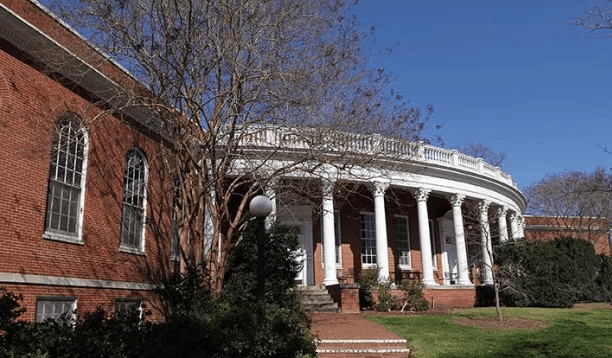Seacobeck Hall to undergo renovations following UMW’s six-year plan
5 min read
University Relations
By SHAWNYA PETERSON
Seacobeck Hall has been an integral part of the University of Mary Washington since its doors opened in 1931. As UMW’s primary dining hall, generations of students have passed through its doors, and it is home to countless fond memories for thousands of students. For the past year, however, it has remained desolate with no students or faculty using its facilities.
However, Seacobeck will be getting a facelift, though it is no stranger to remodeling. Over the years, it has undergone several renovations to better accommodate students’ changing culinary needs over the 80-year history in which it has been open.
This time, however, the renovation is not to install more seating for meal times, but to transform the 43,000 square foot space to provide a new home for the College of Education.
While the renovation of Seacobeck Hall has long been in the works, it has only recently come closer to becoming a reality. “UMW was founded as a teacher’s college, and the program is thriving at the present time,” said UMW Provost Dr. Joseph Levin. “It will be important to ensure that we’re delivering a state-of- the-art education program, utilizing state-of- the-art classrooms and technologies and utilizing space to enhance the sense of community among education students.”
Levin continued, “I believe that the renovated Seacobeck will be a point of pride for students, not only those in the College of Education, but also those who will use the building for the other academic purposes that the building will serve.”
When asked about the changes that will be made to the building, Levin said, “The basic structure of the building won't change, but we will explore ways to use the space creatively, in service of our academic programs. It's a wonderfully distinctive building, and I think the right architect will come up with some very innovate ideas.”
Levin also discussed the importance of maintaining the building’s historical integrity throughout renovations. “The building was preserved, in part, because of its historical significance. We will work with our own historical preservation team, including professor Michael Spencer, as well as with those charged with overseeing these issues on the state agency side.”
Madeleine McCullough, a sophomore history major, expressed excitement over the upcoming changes.
“I think it’s a good thing, having our own department [building] would be cool,” McCullough said. “More space for programs would be great.”
Indeed, space is a significant factor in the renovations. The plans outlined in the university’s six- year plan discuss transitioning the building from an “auxiliary space” to classrooms for the College of Education.
When asked about the renovation start date as well as the budget for the project, Levin admitted that it was “far too early to say,” and that the renovation budget, outside of the fees needed to “support the planning process,” is currently unknown.
Despite the many uncertainties, Levin estimates that once it starts, possibly “within another year or so,” the renovation will be “an 18-month process, give or take a few months.” The renovations are in such an early stage of being carried out, many students that are new to the Education Department have not yet heard the news.
“I hadn’t even heard of that happening,” says Emma Jones, a sophomore German major. “I think that sounds like a good idea. They need to do something with Seacobeck, and it will be good to have the education program in one unified space.” Jones added, “Since I’m so new to the program, I don’t have many expectations. I hope that having a spot just for the education program will make resources more accessible.”
Despite the positive growth these changes may bring, the renovation will undoubtedly come with a hefty price tag.
In the interview, Levin made sure to emphasize exactly who would be carrying the cost of Seacobeck’s updates. “Because the renovated building will be an academic space, the cost of the renovation will be carried entirely by the state. Once the building is renovated, we will take on the cost of maintaining the building.”
He continued, “At this time, it is impossible to say how the [maintenance costs] will be carried, but it is important to note that students will not be asked to carry the cost of the actual renovation.”
Opened in the fall of 2015, the new University Center famously cost a whopping $56 million to build. When the UC took Seacobeck’s place as the primary dining hall on campus, Seacobeck’s operating budget was also transferred over to the UC.
According to the UMW Board of Visitors six-year plan, now students’ tuition will need to be raised to fill the gap between the funding provided and the funding needed to come up with a new operating budget for Seacobeck after renovations are complete.
“The annual operating budget is estimated at $175,000 and includes utilities, housekeeping and security services. To the extent that general funds are not provided for operation and maintenance, student tuition and fees will need to be increased to cover these costs,” according to UMW’s six-year plan.
As the official plans for Seaco have not yet been finalized, much is still subject to change. Even so, not all are enthusiastic about the prospect of yet another tuition spike.
Drew Shannon, a sophomore political science major, expressed disappointment in the administration’s financial choices in terms of Seacobeck.
“While I’m glad to see development to a building that currently seems wasted, I’m disheartened to see another countless example of this university pushing every cost imaginable onto the students,” Shannon said.
Senior English major, Sarah Hansen, took a moment to reminisce on the picturesque building that is central to so many of her college memories.
“Seaco is an architecturally beautiful building and an important piece of Mary Washington’s history,” Hansen said. “I miss sharing meals with my friends there, but I am so glad that the building is going to be renovated, rather than torn down. One of Seaco’s greatest features is its gorgeous windows, so I hope that the renovations keep the space bright and airy.”
Levin expressed a similar sentiment. “One thing that we learned when we began discussions about the University Center is that Seacobeck is one of the best loved buildings on campus. Seacobeck is an amazing campus resource, and we intend to make it shine in its next iteration.”
While we may not know the specifics about the changes in store for Seacobeck, one thing is for certain, the building beloved by so many students is going to be given a new life, and will be there to be enjoyed by generations of students to come.











